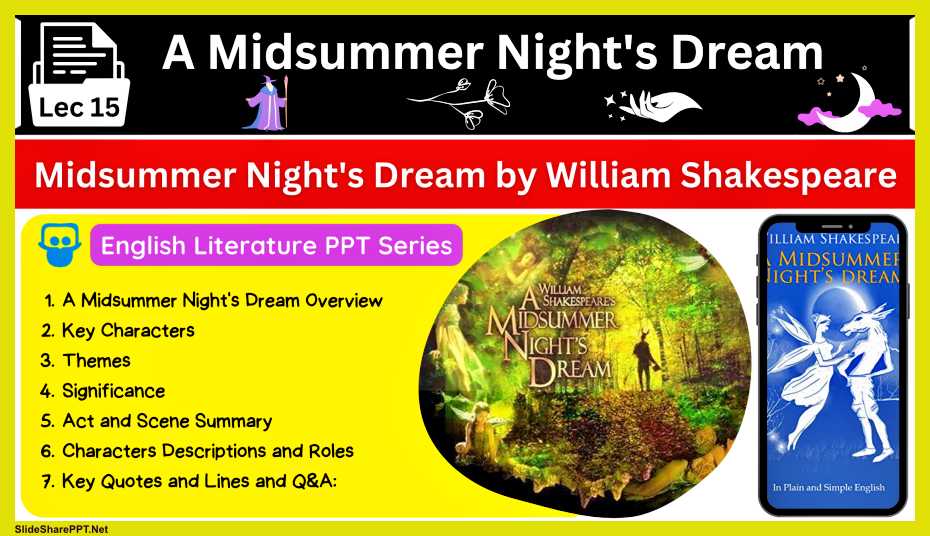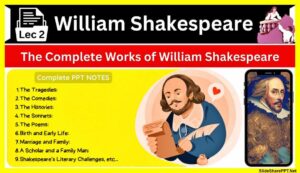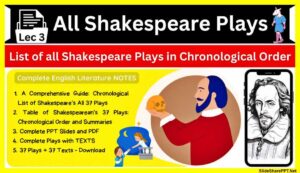A Midsummer Night’s Dream Play by William Shakespeare (Complete)
Today we have shared the Notes – A Midsummer Night’s Dream Play by William Shakespeare PPT Slides & PDF Download. So, as we know William Shakespeare’s “A Midsummer Night’s Dream” has long captivated audiences with its whimsical blend of romance, fantasy, and humor. This enchanting play, believed to have been written between 1590 and 1596, transports viewers into a world where the ordinary and the supernatural collide in a delightful tapestry of interconnected stories. Set in the ancient city of Athens and the mystical forest realm, the play weaves together the adventures of four young lovers, a group of amateur actors, and mischievous fairies, creating a rich tapestry of human emotions and whimsical escapades. As one of Shakespeare’s most beloved works, “A Midsummer Night’s Dream” continues to charm and inspire audiences across generations, showcasing the playwright’s enduring mastery of storytelling and the complexities of the human experience.
About: A Midsummer Night’s Dream
- “A Midsummer Night’s Dream,” a comedic masterpiece composed by William Shakespeare around 1595 – 1596 or 590 – 1596, is set in the ancient Greek city of Athens. The play intertwines elements of romance, fantasy, and farce, revolving around the upcoming marriage of Duke Theseus of Athens and Queen Hippolyta, the Queen of the Amazons.
- Shakespeare drew inspiration from various sources, infusing the play with mythical and literary references. Ovid’s “Metamorphoses” influences the magical transformations and themes of love and desire, while Chaucer’s “The Knight’s Tale” contributes to the aristocratic setting and romantic complexities. Additionally, echoes of Aristophanes’ comedic style, particularly in “The Birds,” can be seen in the play’s whimsical and playful portrayal of the supernatural realm, inhabited by fairies and enchantments.
- Through its interplay of mortal and magical characters and its exploration of themes such as love, identity, and the power of imagination, “A Midsummer Night’s Dream” continues to captivate audiences with its timeless wit and enchanting narrative.
A Midsummer Night’s Dream PPT Slides
(Lec 15)
Important:-
- If you are viewing this PPT on your phone, please make it full screen and then view it. (Press: 3 dots in PPT, then Full Screen)
- If you have a problem while clicking on next, (Just tap) on the slide instead of clicking Next Botton.
- FOR A BETTER VIEW PRESS Ctrl + Shift + F ON A PC OR LAPTOP.
- Whatever is written in the PPT is different and whatever is written below is different.
Table: A Midsummer Night’s Dream
Here’s a complete table of “A Midsummer Night’s Dream”:
| Aspect | Description |
|---|---|
| Title | A Midsummer Night’s Dream |
| Playwright | William Shakespeare |
| Genre | Comedy |
| Date of Composition | Estimated to be between 1594 and 1596 |
| Setting | Athens and a nearby enchanted forest |
| Main Characters | Theseus, Hippolyta, Hermia, Lysander, Helena, Demetrius, Oberon, Titania, Puck (Robin Goodfellow) |
| Plot Overview | The play intertwines the adventures of four young lovers, a group of amateur actors, and the fairies who inhabit the forest. Their intersecting journeys are influenced by the mischievous actions of the fairy Puck, resulting in a series of comic and magical events. |
| Key Themes | Love, illusion vs. reality, the supernatural, the power of imagination |
| Significance | “A Midsummer Night’s Dream” is one of Shakespeare’s most popular and enduring comedies, known for its enchanting blend of romance, fantasy, and humor. It explores themes of love and desire while showcasing the transformative power of the imagination. |
| Notable Lines | – “The course of true love never did run smooth.” (Act 1, Scene 1) – “Lord, what fools these mortals be!” (Act 3, Scene 2) – “Love looks not with the eyes, but with the mind, / And therefore is winged Cupid painted blind.” (Act 1, Scene 1) |
| Adaptations | Various stage productions, film adaptations, and television adaptations have been made over the years. Notable adaptations include the 1999 film directed by Michael Hoffman and numerous stage productions by theater companies around the world. |
This table provides a comprehensive overview of various aspects of “A Midsummer Night’s Dream,” including its background, plot, characters, themes, significance, notable lines, and adaptations.
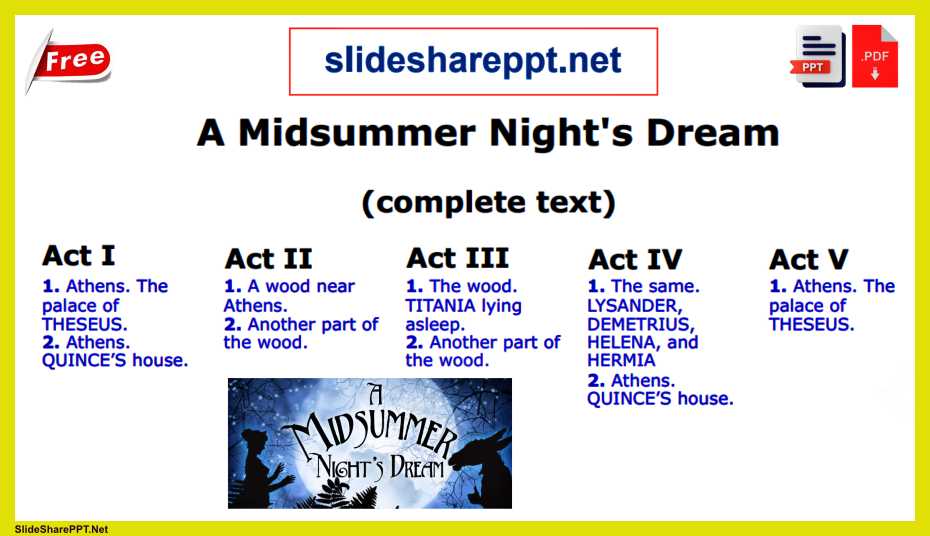
Note: The complete Text PDF Link is at the end of the PowerPoint slides (go to the last PPT Slide)
Summary: A Midsummer Night’s Dream
“A Midsummer Night’s Dream” is one of William Shakespeare’s most beloved and enduring comedies, known for its whimsical plot, fantastical elements, and exploration of themes such as love, magic, and the nature of reality. Written between 1594 and 1596, the play has captivated audiences for centuries with its enchanting story and memorable characters.
The play is set in Athens and the surrounding forest, where the worlds of mortals and fairies intersect, creating a tapestry of love entanglements and comedic misunderstandings. The story revolves around four young lovers: Hermia, Helena, Lysander, and Demetrius. Hermia loves Lysander, but her father insists she marry Demetrius. Hermia and Lysander plan to flee to the forest to escape this arranged marriage.
- Meanwhile, a group of Athenian tradesmen, led by the comically inept Peter Quince, is preparing a play to perform at the Duke’s wedding. These “mechanicals” stumble into the forest as well, adding to the chaos.
- In the fairy realm, Oberon, the king of the fairies, and his mischievous servant Puck (also known as Robin Goodfellow) manipulate the lovers and the mechanicals using a magical flower that causes people to fall in love with the first person they see. Oberon wants to help Helena, who is in unrequited love with Demetrius, so he instructs Puck to use the flower on Demetrius. However, Puck mistakes Lysander for Demetrius, leading to even more confusion and hilarity.
- As the night unfolds, the lovers wander the enchanted forest, their feelings and identities shifting under the influence of magic. Eventually, Oberon sets things right, and the play concludes with the lovers happily reunited, the mechanicals hilariously performing their play for the Duke, and blessings bestowed upon the newlyweds.
Here is a complete table outlining the plot summary of William Shakespeare’s play “A Midsummer Night’s Dream”:
| Act | Scene | Summary |
|---|---|---|
| Act 1 | Scene 1 | Theseus, Duke of Athens, plans his upcoming wedding to Hippolyta, Queen of the Amazons. Egeus brings his daughter Hermia before the Duke, demanding she marry Demetrius instead of her true love, Lysander. Theseus gives Hermia an ultimatum: marry Demetrius, face execution, or become a nun. |
| Act 1 | Scene 2 | Hermia and Lysander decide to flee to Lysander’s aunt’s house outside Athens to marry in secret. They confide in Helena, Hermia’s friend who is in unrequited love with Demetrius. Hoping to win Demetrius’s favor, Helena divulges their plan to him, hoping he will love her in return. |
| Act 2 | Scene 1 | A group of Athenian tradesmen, led by Peter Quince, rehearses a play they plan to perform at the Duke’s wedding. They assign roles and prepare for their performance. |
| Act 2 | Scene 2 | Meanwhile, Oberon, King of the Fairies, and his queen, Titania, quarrel over a changeling boy. Oberon seeks revenge by having his mischievous servant, Puck, use a magical flower to make Titania fall in love with something ridiculous. Oberon also orders Puck to use the flower to make Demetrius fall in love with Helena. |
| Act 3 | Scene 1 | The young lovers enter the enchanted forest outside Athens. Puck mistakenly applies the flower’s magic to Lysander instead of Demetrius, causing chaos as Lysander now loves Helena. Hermia and Helena argue while the men duel for Helena’s affections. |
| Act 3 | Scene 2 | The Mechanicals enter the forest to rehearse their play. Puck transforms Bottom’s head into that of an ass, causing his companions to flee in terror. Titania wakes and falls in love with Bottom due to Oberon’s magic, further complicating matters. |
| Act 4 | Scene 1 | Oberon realizes Puck’s mistake and orders him to fix the love entanglements. Puck uses his magic to restore Lysander’s love for Hermia and Demetrius’s love for Helena. Titania and Oberon reconcile, ending their feud. |
| Act 5 | Scene 1 | Theseus and Hippolyta discover the lovers and the Mechanicals in the forest. They watch the Mechanicals’ hilariously inept performance of “Pyramus and Thisbe” and retire for the night. The play concludes with blessings upon the newlyweds and a celebration of love and harmony. |
This table summarizes the main events and key scenes of “A Midsummer Night’s Dream,” highlighting the intertwining plots of love, magic, and mistaken identities that drive the comedic and fantastical elements of Shakespeare’s play.
Themes
Here is a complete table outlining the themes explored in William Shakespeare’s play “A Midsummer Night’s Dream”:
| Theme | Description |
|---|---|
| Love and Desire | The play delves into various forms of love, including unrequited love (Helena for Demetrius), forbidden love (Hermia and Lysander), and magical love (via Oberon’s love potion). It explores the complexities and irrationalities of love. |
| Reality vs. Illusion | The magical forest setting blurs the lines between reality and illusion, highlighting the subjective nature of perception and the transformative power of imagination. |
| Order and Disorder | The structured society of Athens contrasts with the chaotic and unpredictable nature of the forest, reflecting the tension between societal expectations and individual desires. |
| Transformation and Metamorphosis | Characters undergo physical (Bottom’s donkey head) and emotional transformations (love spells) that symbolize personal growth, enlightenment, and the fluidity of identity. |
| Nature and Supernatural | The natural world of the forest, inhabited by fairies and magical beings, intersects with the human world, emphasizing the mystical and mysterious aspects of existence. |
| Dreams and Reality | The play blurs the boundaries between dreams and waking life, suggesting that dreams can reveal deeper truths about desires, fears, and the human psyche. |
| The Power of Language | Shakespeare utilizes language as a tool for comedic effect, dramatic irony, and enchantment, showcasing the influence of words and rhetoric on shaping perceptions and actions. |
| The Folly of Human Behavior | Characters’ actions driven by love, jealousy, and ambition lead to comedic misunderstandings and chaotic situations, highlighting the absurdity and unpredictability of human nature. |
These themes collectively contribute to the richness and depth of “A Midsummer Night’s Dream,” offering insights into human relationships, societal norms, and the interplay between reality and imagination within the context of a magical and whimsical narrative.
Characters
Here is a table featuring the important characters from William Shakespeare’s play “A Midsummer Night’s Dream”:
| Character | Description |
|---|---|
| Theseus | Duke of Athens who is marrying Hippolyta as the play begins. He decrees that Hermia must marry Demetrius or face death or live as a nun, setting the conflict in motion. |
| Hippolyta | Queen of the Amazons and betrothed to Theseus. Though once enemies, Theseus won her in battle, and they are now set to be married at the beginning of the play. |
| Lysander | Hermia’s lover who plans to escape to her widow aunt’s house with her due to Theseus’ decree. He claims to be Demetrius’s equal in love but faces challenges and misunderstandings due to Puck’s intervention with the love potion. |
| Demetrius | In love with Hermia at the beginning of the play but previously loved Helena. He is manipulated by Oberon’s love potion, leading to shifting affections and eventual marriage to Helena. |
| Hermia | In love with Lysander but faces pressure from her father and Theseus to marry Demetrius. She chooses to elope with Lysander, leading to complications and challenges in the enchanted forest. She later marries Lysander after resolving their issues. |
| Helena | Cruelly pursued by Demetrius, who once loved her before favoring Hermia. Helena’s unrequited love and subsequent manipulation by Oberon’s potion result in her eventual marriage to Demetrius. |
| Oberon | King of the fairies who manipulates events with the love potion, causing chaos and misunderstandings among the mortal characters. |
| Titania | Oberon’s wife and queen of the fairies, engaged in a dispute with Oberon over custody of an Indian boy. |
| Puck (Robin Goodfellow) | Also known as Robin Goodfellow, Oberon’s mischievous servant is responsible for the mistaken application of the love potion, leading to comedic and dramatic consequences. |
| Nick Bottom | A weaver who takes on the role of Pyramus in the Mechanicals’ performance of “Pyramus and Thisbe,” showcasing comedic elements and theatrical absurdity within the play. |
| Egeus | Hermia’s father who insists on her marriage to Demetrius, setting the initial conflict in the play. |
| Philostrate | Arranges the selection for the performance at Theseus’ wedding, adding a theatrical element to the celebration. |
| Peter Quince | A carpenter and the director of the actors who perform “Pyramus and Thisbe,” showcasing the humorous incompetence of the Mechanicals. |
| Francis Flute | A bellows mender who reluctantly plays the role of Thisbe in the Mechanicals’ play. |
| Tom Snout | A tinker who plays the role of Wall in the Mechanicals’ play, adding comedic elements to the performance. |
| Robin Starveling | A tailor who plays the role of Moonshine in the Mechanicals’ play, contributing to the absurdity and humor of the performance. |
| Peaseblossom, Cobweb, Moth, Mustardseed | Fairies serving under Titania, adding a magical and whimsical element to the enchanted forest scenes. |
These characters play vital roles in the intertwining plots of love, magic, and comedy within “A Midsummer Night’s Dream,” showcasing Shakespeare’s skill in creating diverse and memorable characters.
Also read: Auto journalism
Significance and Legacy
“A Midsummer Night’s Dream” continues to be performed and studied worldwide, cherished for its enchanting story, memorable characters, and rich exploration of timeless themes. Its blend of comedy, romance, and fantasy appeals to audiences of all ages, making it a perennial favorite in theaters, schools, and literary circles.
Here is a complete table outlining the significance and legacy of William Shakespeare’s play “A Midsummer Night’s Dream”:
| Aspect | Description |
|---|---|
| Literary Influence | A Midsummer Night’s Dream is a quintessential example of Shakespearean comedy, characterized by its light-hearted tone, fantastical elements, and exploration of romantic entanglements. It has influenced countless comedic plays, novels, and films, inspiring adaptations and reinterpretations across various media and cultural contexts. |
| Exploration of Love | The play delves into the complexities of love, from unrequited longing to magical enchantment, offering insights into human desires, passions, and follies. Its exploration of romantic relationships continues to resonate with audiences, making it a timeless portrayal of the joys and challenges of love. |
| Theatrical Innovation | Shakespeare’s use of a play within a play (the Mechanicals’ performance of “Pyramus and Thisbe”) adds layers of humor and meta-theatricality, showcasing his ingenuity and skill in blending comedic elements with theatrical commentary. This innovation has influenced subsequent works that incorporate self-referential storytelling. |
| Themes of Identity | The play’s magical transformations, mistaken identities, and the interplay between reality and illusion highlight themes of identity and self-discovery. Characters undergo physical and emotional changes, challenging perceptions of self and others, and inviting exploration of the fluidity and complexity of human identities. |
| Popular Culture | The characters and themes of A Midsummer Night’s Dream have permeated popular culture, appearing in films, television shows, novels, music, and artwork. References to the play’s iconic scenes, such as the enchanted forest and Bottom’s transformation, are widely recognized and celebrated in diverse artistic expressions. |
| Influence on Fantasy | The fantastical elements of fairies, magic spells, and enchanted forests in the play have influenced fantasy literature and storytelling traditions. Its portrayal of magical realms and whimsical creatures has contributed to the enduring appeal of fairy tales and fantasy genres in literature and media. |
| Performance Tradition | A Midsummer Night’s Dream remains a staple of theater productions worldwide, from traditional interpretations to innovative adaptations. Its enduring popularity in theatrical circles showcases its versatility and ability to resonate with diverse audiences across generations. |
| Educational Value | The play’s rich language, nuanced characters, and thematic depth make it a valuable educational tool for studying Shakespearean drama, comedic techniques, literary themes, and historical contexts. It continues to be taught in schools and universities as part of literature and theater curricula globally. |
These aspects collectively highlight the lasting significance and multifaceted legacy of “A Midsummer Night’s Dream” as a seminal work in English literature, theatrical innovation, and cultural storytelling.
- Shakespeare’s masterful use of language, wit, and imagination shines through in this play, showcasing his ability to weave together intricate plots, vivid characters, and profound insights into the human condition. From its magical setting to its whimsical portrayals of love and folly, “A Midsummer Night’s Dream” remains a testament to the enduring power of Shakespeare’s genius and the timeless appeal of great storytelling.
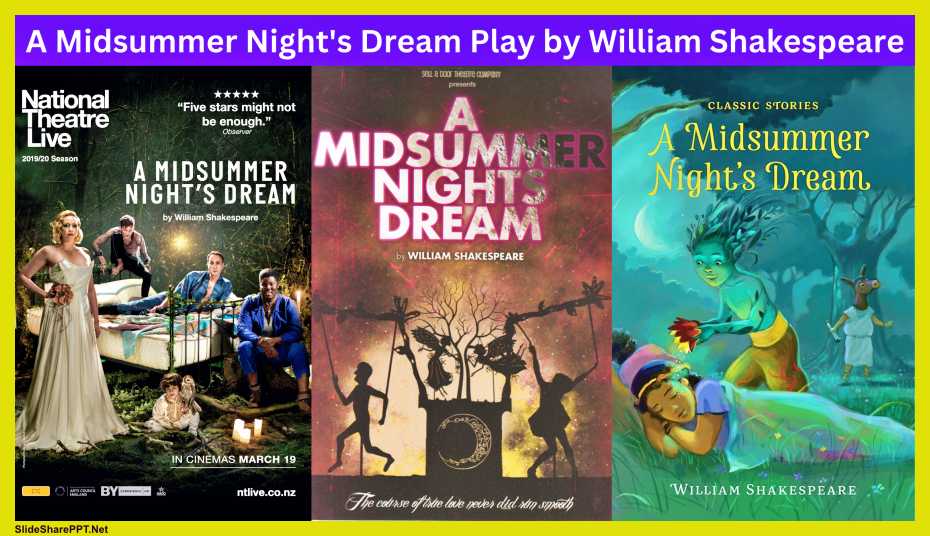
Key Quotes and Lines
Here is a table featuring the 21 important quotes from William Shakespeare’s play “A Midsummer Night’s Dream”:
| Character & Acts | Quote | Context |
|---|---|---|
|
Hippolyta (Heyppolyta to Theseus Act I, Se-I ) |
“Four days will quickly steep themselves in night; Four nights will quickly dream away the time.” | Hippolyta reflects on the anticipation of their upcoming wedding and the fleeting nature of time. |
|
Theseus (Theseus to Hermia Act I, Sc-I) |
“To you your father should be as a god, One that composed your beauties.” | Theseus advises Hermia to respect and honor her father, emphasizing parental authority and admiration. |
|
Theseus (Theseus to Hermia, Act I, Sc. I ) |
“But earthlier happy is the rose distilled Than that which, withering on the virgin thorn, Grows, lives, and dies in single blessedness.” | Theseus compares different forms of happiness and relationships, highlighting the complexities of love and contentment. |
|
Lysander (Lysander to Hermia – Act I, Sc-I) |
“The course of true love never did run smooth.” | Lysander acknowledges the challenges and obstacles often faced in genuine romantic relationships. |
|
Hermia (Hermia to Lysander, Act I, Sc. I) |
“O hell! To choose love by another’s eyes.” | Hermia expresses frustration at being judged and controlled based on others’ perceptions of love. |
|
Lysander (Lysander to Hermia, Act I, Act I, Sci I) |
“Behold! The jaws of darkness do devour it up; So quick bright things come to confusion.” | Lysander reflects on the fleeting nature of happiness and beauty, noting how quickly circumstances can change. |
|
Helena (Helena to herself Act I, Sc-I) |
“Love looks not with the eyes but with the mind, And therefore is winged Cupid painted blind.” | Helena muses on the deeper understanding of love beyond physical appearances, referencing Cupid’s blindness to true emotions. |
|
Oberon (Oberon to Titania, Act II, Sc. I) |
“I’ll met by Eight proud Titania Moonlight.” | Oberon plans to meet Titania in the moonlight, setting the stage for magical interventions in the forest. |
|
Puck (Puck to Oberon, Act II, Sc-I) |
“I’ll put a girdle round about the earth in forty minutes.” | Puck boasts about his magical abilities and swiftness in carrying out Oberon’s commands. |
|
Helena (Helena to Demetrious, Act I, Sc-I) |
“My heart is as true as steel.” | Helena expresses her unwavering commitment and loyalty in love, showcasing her steadfastness. |
|
Bottom (Bottom Act III, sc -I) |
“A lion among ladies is the most dreadful thing.” | Bottom humorously exaggerates his fearsome presence as an actor playing a lion in a play. |
|
Quince (Quince Act III, sc. I) |
“O monstrous! O strange! We are haunted. Pray, masters! Fly, masters! Help!” | Quince reacts dramatically to the sight of Bottom with an ass’s head, showcasing the comedic chaos in the play. |
|
Quince (Quince Act II, Sc 2) |
“Bless thee, Bottom! Bless thee, thou art translated.” | Quince marvels at Bottom’s transformation, displaying a mix of amazement and humor. |
|
Bottom (Bottom to Tutania. Act III, Sc -I) |
“And yet to say the truth, reason and love keep little company together nowadays.” | Bottom reflects on the discord between rationality and emotions in relationships and life. |
|
Puck (Puck to Oberon Act III, Sc. II) |
“Lord, what fools these mortals be!” | Puck observes the foolishness and whims of humans, adding a comedic and insightful perspective. |
|
Puck (Puck to Oberon Act III, Sc II) |
“And those things do best please me, That do befall preposterously.” | Puck revels in chaos and absurdity, finding delight in unconventional and whimsical events. |
|
Hermia (Hermia to herself Act III, Sc II) |
“I am amazed and know not what to say.” | Hermia expresses surprise and bewilderment at the strange events unfolding around her. |
|
Puck (Puck to himself Act II, Sc. II) |
“Cupid is a knavish lad, Thus to make poor females mad.” | Puck humorously comments on Cupid’s mischievousness in causing romantic chaos and confusion. |
|
Bottom (Bottom to Tutania, Act IV, Sc-I) |
“I have had an exposition of sleep come upon me.” | Bottom comically describes falling asleep and having strange dreams or visions. |
|
Demetrius (Demetrious to Hermia Act IV, Sc- I) |
“It seems to me that yet we sleep, we dream.” | Demetrius reflects on the surreal nature of their experiences, blurring the lines between reality and fantasy in the enchanted forest. |
|
Theseus (Theseus to Huppolyta Act V, Sc I) |
“Lovers and madmen have such seething brains, Such shaping fantasies, that apprehend More than cool reason ever comprehends.” | Theseus reflects on the imaginative and passionate nature of lovers and dreamers, contrasting it with rational thinking. |
These quotes capture key moments, emotions, and themes in “A Midsummer Night’s Dream,” showcasing Shakespeare’s wit, humor, and insight into human relationships and experiences.
Remaining Quotes
Here is a table featuring key quotes and lines from William Shakespeare’s play “A Midsummer Night’s Dream”:
| Character | Quote | Context |
|---|---|---|
| Puck | “Lord, what fools these mortals be!” | Puck observes the foolishness and irrationality of human behavior, especially in matters of love and desire. |
| Oberon | “I know a bank where the wild thyme blows, Where oxlips and the nodding violet grows…” | Oberon describes the enchanting and magical setting of the forest, where he plans to use his magic to manipulate the lovers. |
| Hermia | “And though she be but little, she is fierce.” | Hermia’s defiance and determination are highlighted in this line, emphasizing her strength despite her petite stature. |
| Bottom | “I have had a most rare vision. I have had a dream, past the wit of man to say what dream it was.” | Bottom comically recounts his experience of being transformed into a donkey by Puck’s magic, unaware of the absurdity of his situation. |
| Helena | “Love looks not with the eyes, but with the mind, And therefore is winged Cupid painted blind.” | Helena reflects on the irrationality of love, suggesting that true love transcends physical appearances and is guided by emotions and perceptions. |
| Theseus | “The lunatic, the lover, and the poet, Are of imagination all compact.” | Theseus compares the creative imagination of poets and lovers to the fanciful ideas of madmen, highlighting the power and unpredictability of imagination. |
| Titania | “These are the forgeries of jealousy.” | Titania accuses Oberon of creating illusions and disruptions in nature out of jealousy and spite, reflecting themes of envy and manipulation. |
| Lysander | “The course of true love never did run smooth.” | Lysander acknowledges the challenges and obstacles faced in romantic relationships, emphasizing the difficulties of love. |
| Quince | “Bless thee, Bottom, bless thee! Thou art translated.” | Quince marvels at Bottom’s sudden transformation with humorous sincerity, reflecting the play’s themes of magical metamorphosis. |
| Demetrius | “O Helen, goddess, nymph, perfect, divine! To what, my love, shall I compare thine eyne?” | Demetrius, under the spell of Puck’s magic, expresses exaggerated adoration for Helena, highlighting the effects of enchantment on perception. |
These quotes capture the essence of key characters, themes, and memorable moments in “A Midsummer Night’s Dream,” showcasing Shakespeare’s wit, insight, and mastery of language in creating enduring literary and theatrical moments.
QnA:
1. Q: What role does magic play in the events of the play?
- Answer: Magic, particularly through the actions of characters like Oberon and Puck, drives much of the plot in “A Midsummer Night’s Dream.” Oberon’s use of a love potion creates chaotic and humorous situations among the lovers, leading to mistaken identities, romantic entanglements, and comedic misunderstandings. Puck’s mischievous nature and magical interventions further complicate the characters’ experiences, highlighting the fantastical elements and whimsical nature of the play.
2. Q: How does Shakespeare explore the theme of love in the play?
- Answer: Shakespeare examines various facets of love, including romantic love, unrequited love, and the complexities of desire. The interactions between characters like Hermia, Lysander, Helena, and Demetrius showcase the irrationality and intensity of romantic emotions. The play also delves into themes of loyalty, fidelity, and the transformative power of love, especially through magical influences that challenge characters’ perceptions and affections.
3. Q: What is the significance of the play within the play, “Pyramus and Thisbe”?
- Answer: The inclusion of the Mechanicals’ comically inept performance of “Pyramus and Thisbe” adds layers of humor, parody, and meta-theatricality to the play. It satirizes traditional dramatic conventions and amateur theatrical productions of Shakespeare’s time while providing comic relief amidst the romantic entanglements of the main plot. The juxtaposition of high drama and low comedy enhances the overall theatrical experience and highlights Shakespeare’s skillful blending of genres.
4. Q: How do the settings of Athens and the enchanted forest contribute to the play’s themes?
- Answer: The contrast between the structured, rational world of Athens and the magical, unpredictable realm of the forest symbolizes the themes of order versus chaos, reality versus illusion, and societal expectations versus individual desires. The forest serves as a transformative space where characters undergo personal growth, self-discovery, and reconciliation. It also allows for the exploration of themes such as dreams, imagination, and the blurred boundaries between reality and fantasy.
5. Q: What insights does the play offer into human nature and behavior?
- Answer: Through the characters’ interactions, Shakespeare illuminates aspects of human folly, ambition, jealousy, and resilience. The play highlights the unpredictability of emotions, the consequences of impulsive actions, and the power dynamics inherent in relationships. The comedic elements and exaggerated situations also invite reflection on societal norms, identity, and the enduring complexities of love and desire.
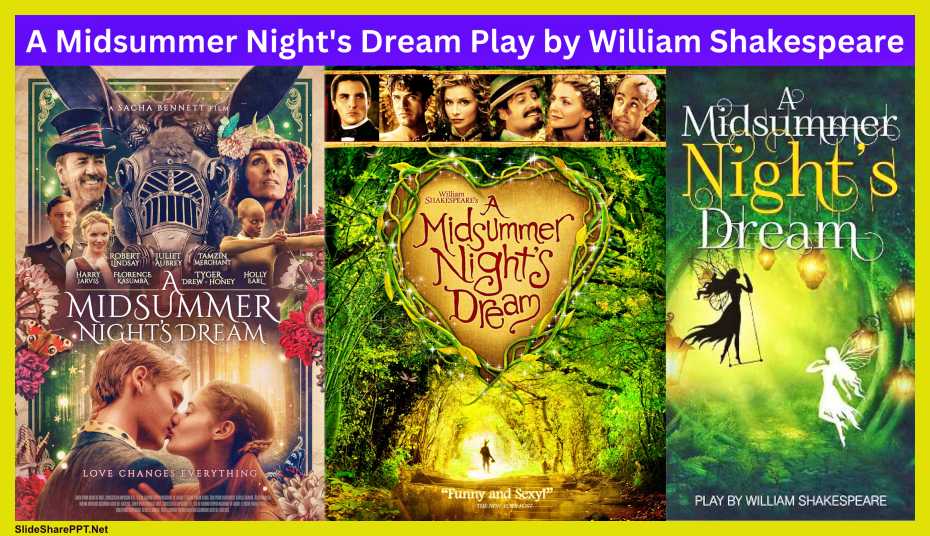
MCQ:
Q.1. What is the probable date of composition of A Midsummer Night’s Dream?
(a) 1564
(b) 1595
(c) 1606
(d) 1611
ans – b
Q. 2. Which day is known as ‘Midsummer Night’?
(a) December 31
(b) June 15
(c) June 24
(d) August 15
ans – c
Q. 3. When was the play first published?
(a) 1594
(b) 1600
(c) 1608
(d) 1616
ans – b
Q. 4. In what size was this play first published?
(a) In Quarto
(b) In Folio
(c) In Octavo
(d) In Sesto
ans – a
Q. 5. How is the play categorized?
(a) A Comedy
(b) A Tragedy
(c) A Tragi-comedy
(d) A Farce
ans – a
Q. 6. How do you classify the play?
(a). A Tragi-comedy
(b) A Masque
(c) A Farce
(d) A One-Act-play.
ans – b
Q. 7. Name the location of the Scenes of the play.
(a) Forest of Arden
(b) Athens and the Wood near it
(c) Thessaly
(d) France
ans – b
Q.8. How many Acts and scenes does the play contain?
(a) Acts 5, Scenes 9
(b) Acts 4, Scenes 6
(c) Acts 6, Scenes 13
(d) Acts 9, Scenes 15
ans – a
Q.9. Who opens the first Scene of Act I?
(a) Lysander
(b) Egeus
(c) Hermia
(d) Theseus v
ans – d
Q.10. What was the complaint of Egeus, father of Hermia, to Theseus the Duke?
(a) That Hermia loves Demetrius
(b) That Hermia refuses to marry Demetrius
(c) That Helena loves Theseus
(d) That Helena refuses to marry Theseus
ans – b
Q. 11. What is the judgment of Theseus towards Hermia?
(a) To marry Lysander
(b) Not to marry Demetrius
(c) To come to the Court
(d) Either to marry Demetrius or prepare to die under the law of Athens or to take a vow of single life forever.
ans – d
12. The course of true love never did run smooth.” Who said it and to whom?
(a) Lysander to Hermia
(b) Hermia to Lysander
(c) Theseus to Egeus
(d) Demetrius of Helena.
ans – a
Q. 13. Who spoke the following and to whom?
O hell! To choose love from another’s eyes.
(a) Theseus to Egeus
(b) Egeus to Theseus
(c) Hermia to Lysander
(d) Helena to Demetrius.
ans – c
Q. 14. Who is Mustardseed?
(a) A City
(b) A Vegetable
(c) A kind of oil
(d) A Fairy.
ans – d
Q. 15. Who is Oberon?
(a) A Tailor
(b) A lover of Hermia
(c) King of the Fairies
(d) An attendant.
ans – c
Q. 16. Who is the ‘merry wanderer of night?
(a) Puck
(b) Titania
(c) Egeus
(d) Bottom
ans – a
Q. 17 What is the reason for animosity between Oberon and Titania?
(a) Titania refuses to give the Indian boy to Oberon
(b) Oberon refuses to give Titania the Indian boy
(c) Titania does not like the reveleries of the king
(d) Oberon has asked Puck to pour love juice into the eyes of Titania.
ans – a
Q. 18. What time does Puck take to go round the earth?
(a) One hour
(b) Twenty-four hour
(c) One year
(d) Forty minutes.
ans – d
19. Kindly name the flower whose juice Oberon wishes to pour into the eyes of Titania.
(a) Love-in-idleness
(b) Lily Flower
(c) Cupid Flower
(d) Sleeping Flower.
ans – a
Q. 20. What will be the effect of this juice on Titania?
(a) She will give boy to Oberon
(b) She will start loving whatever she sees first on waking
(c) She will never disobey Oberon
(d) She will not be able to leave sleep then.
ans – b
Q. 21. What does Titania happen to see on waking up?
(a) Ass-headed Bottom
(b) Nimble-footed Puck
(c) Handsome Oberon
(d) Theseus, Duke of Athens.
ans – a
Q. 22. Why is the play to take place?
(a) To celebrate the marriage of Hermia and Lysander
(b) To celebrate the wedding of Theseus
(c) To please Oberon, King of Fairies
(d) To celebrate the Midsummer Night.
ans – b
Q. 23. What do the other artisan actors do seeing the head of an ass on the shoulders of Bottom?
(a) They run away from him
(b) They come round him
(c) They laugh at him
(d) They start beating him.
ans – a
Q. 24. Who can go “swifter than arrow from the Tartar’s bow ?”
(a) Hermia
(b) Lysander
(c) Puck
(d) Titania.
ans – c
Q. 25. What is the second juice that is poured into the eyes of the Fair Queen, having the counter effect on Cupid’s flower?
(a) Diana’s bud
(b) Will O’wisp
(c) Mustardseed
(d) Love flower.
ans – a
Q. 26. What is the effect of Diana’s bud on Titania?
(a) She starts loving Bottom
(b) She starts to loathe the face of Bottom
(c) She does not like Oberon
(d) She begins to quarrel with the Fairy King.
ans – b
Q. 27 Whose cry is better than ever heard in Crete Sparta Thessaly?
(a) The hounds of Theseus
(b) Attendants of Fairies
(c) Horns of Egeus
(d) Children of Hermia.
ans – a
Q. 28. Why does Lysander like to leave Athens with Hermia?
(a) To be away from the anger of Egeus
(b) To enjoy the scenes of this place
(c) To wage a war against Theseus
(d) To keep out of the limit of the Athenian law.
ans – d
Q. 29. Who speaks the following words and to whom?
“The lunatic, the lover, and the poet
Are of imagination all compact.”
(a) Lysander to Hermia
(b) Theseus to Hippolyta
(c) Bottom to Hippolyta
(d) Hermia to Demetrius.
ans – b
Q. 30. Who is Philostrate?
(a) Lover of Hermia
(b) Father of Helena
(c) Master of the Revels of Theseus
(d) King of Fairies
ans – c
Q. 31. Who is Robin Goodfellow?
(a) Puck
(b) Lysander
(c) Egeus
(d) Bottom
ans – a
Q. 32. When, to beguile time Theseus desires some masque or the like, how many titles does Philostrate give him to choose from?
(a) 3
(b) 4
(c) 5
(d) 6
ans – b
Q. 33. Which of the plays does Theseus prefer to be enacted?
(a) The thrice three Muses mourning for the death of
learning, late deceased in beggary
(b) Three Musketeers
(c) A Midsummer Night’s Dream
(d) A tedious brief scene of young Pyramus And his love Thisbe; very tragic mirth.
ans – d
Q. 34. Why does Theseus prefer to see a particular play?
(a) It is very interesting
(b) It is time consuming
(c) It is merry and tragical
(d) It is already very famous.
ans – c
Q. 35. How many marriages took place towards the end of this play?
(a) 7
(b) 5
(c) 3
(d) 1
ans – c
Q. 36. Why was the drama of ‘Pyramus and Thisbe’’ to be staged?
(a) To celebrate the marriage of Hermia with Demetrius
(b) In honour of the wedding of Theseus and Hippolyta
(c) To please Titania, Queen of the Fairies
(d) Oberon wanted it to be staged.
ans – b
Q. 37. Who sang the Epilogue of the play?
(a) Bottom
(b) Puck
(c) Oberon
(d) Mustardseed
ans – b
Q. 38. The present play deals with a pre-historic period but there are many references to Christianity even, such errors are called –
(a) Pre-historism
(b) Post-civilisation
(c) Je Anachronism
(d) Before Christianisms.
ans – c
Q. 39. Besides being very small in size, Fairies are –
(a) Half seen
(b) Invisible to human beings
(c) Black in colour
(d) Lion-like in shape.
ans – b
40. The Athenian Law is valid up to?
(a) Ten miles
(b) Seven Leageus from Athens
(c) Eight Leagues
(d) Fifteen kilometers.
ans – b
Read the Previous Post: King John by William Shakespeare PPT Slides & PDF
